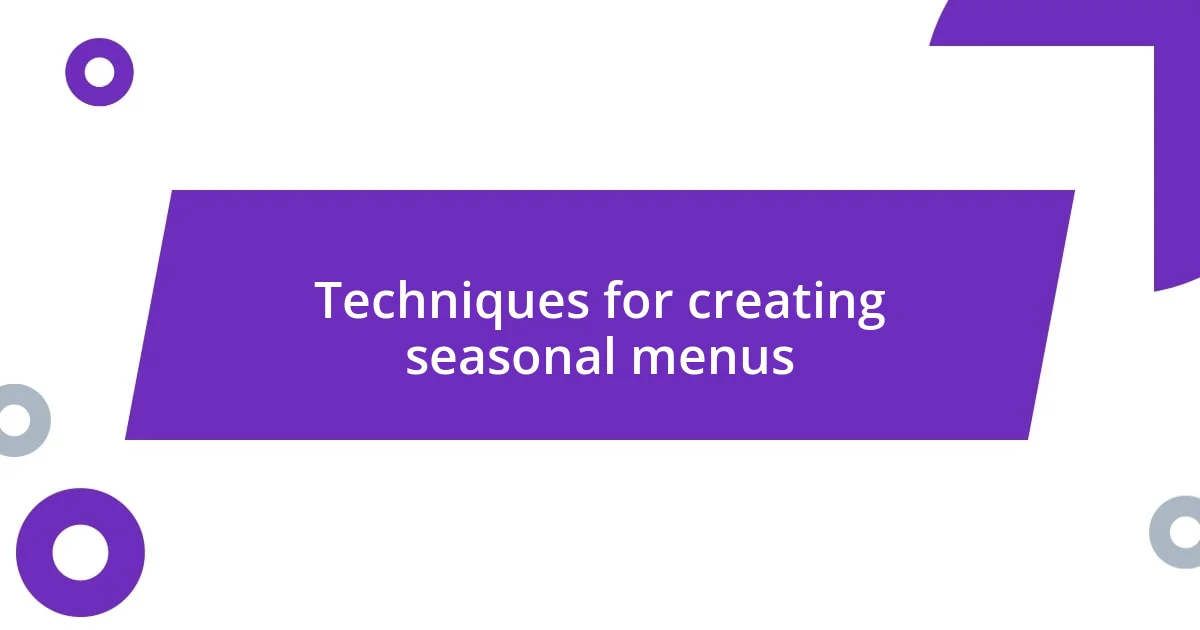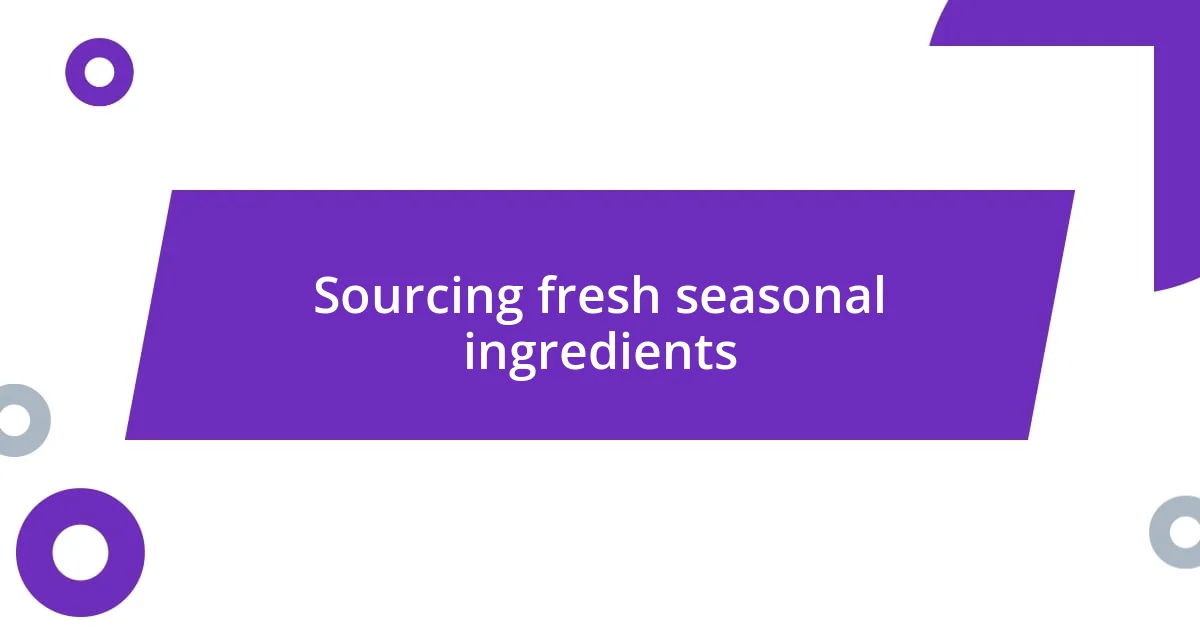Key takeaways:
- Seasonal specials enhance dining experiences by featuring fresh, local ingredients, fostering community connections and storytelling.
- Effective marketing strategies, such as using storytelling and limited-time offers, create emotional engagement and excitement among customers.
- Analyzing customer feedback and sales data is crucial for measuring the success of seasonal specials and maintaining customer loyalty through anticipation of new offerings.

Understanding seasonal specials benefits
Seasonal specials truly offer a refreshing twist that invigorates both the palate and the dining experience. I still remember that summer when I indulged in a vibrant strawberry shortcake that was crafted just when the berries were at their peak. There’s a certain joy in savoring an ingredient at its freshest, and it’s a reminder that food can connect us to the rhythms of nature.
What I find particularly fascinating is how seasonal specials can foster a deeper appreciation for local produce. When I visited a farm-to-table restaurant last fall, the menu highlighted squash and apples, celebrating the bounty of autumn. It’s not just about enjoying delicious food; it’s about feeling tied to the local community and its harvest cycle. Have you ever noticed how much more engaging a meal becomes when it tells a story rooted in its season?
Beyond just the taste, seasonal specials can create a sense of anticipation and excitement. I recall visiting a café that had a reputation for its pumpkin spice latte every October. The thrill of knowing something special is only available for a limited time turns dining into an event. It’s this exclusivity that invites patrons to indulge, generating a buzz that keeps the community vibrant and connected.

Importance of seasonal dishes
Seasonal dishes play a pivotal role in enhancing our connection with food and the environment. I remember a gloomy winter day when I treated myself to a hearty bowl of butternut squash soup. The warm, creamy texture and earthy flavors felt like a hug in a bowl, lifting my spirits. These dishes remind us how culinary choices can change with the seasons, creating comfort and contentment as we adapt to the rhythms of nature.
Moreover, incorporating seasonal ingredients also supports local farmers and sustainable practices. I once participated in a community-supported agriculture program, receiving fresh produce every week. The excitement of unearthing what was in season—like vibrant heirloom tomatoes or fragrant basil—felt empowering. This not only nourished my body but also deepened my understanding of the land where our food originates. Isn’t it enriching to know that the fruits of our plates often come from just down the road?
The importance of seasonal dishes extends to fostering creativity in cooking, too. I fondly recall a vibrant summer cookout where my friends and I turned a simple barbecue into an explosion of flavors using local corn and zucchini. We crafted colorful salads and fresh salsas, showcasing the best of what summer could offer. This creativity not only produced delicious meals but also strengthened friendships, reminding me that the joy of sharing food is truly magnified when embracing what’s in season.
| Aspect | Importance |
|---|---|
| Freshness | Seasonal dishes are made with ingredients at their peak, providing superior taste and nutritional value. |
| Local Support | These dishes promote local agriculture, helping to sustain community farms and reduce transportation footprints. |
| Creativity | Seasonal cooking encourages innovation in the kitchen, allowing for unique flavor combinations and presentations. |
| Connection | Enjoying seasonal dishes fosters a deeper relationship with food, enhancing our appreciation for nature’s cycles. |

Techniques for creating seasonal menus
Creating seasonal menus is an art that combines creativity with an appreciation for freshness. In my experience, one effective technique is to adopt a ‘market-driven approach.’ This means regularly visiting local farmers’ markets or grocery stores to see which ingredients are at their peak. One sunny Saturday, while browsing a market, I stumbled upon a vibrant array of heirloom tomatoes that inspired a whole new salad for my weekend dinner. Suddenly, my menu transformed around these colorful gems, elevating the dining experience with vibrant flavors and stories I could share with my guests.
Consider these techniques to enrich your seasonal menu development:
- Research Local Seasonality: Understand what ingredients are in season within your region to guide your menu planning.
- Focus on Flavor Profiles: Pair seasonal ingredients thoughtfully. For example, how about combining freshly caught seafood with zesty citrus for a summer dish?
- Highlight Community Connections: Share stories behind specific ingredients. Guests love hearing about local farms, which deepens their dining experience.
- Experiment Regularly: Don’t shy away from trying new things. Last fall, I decided to infuse maple syrup into a savory dish, surprising my diners with an unexpected yet delightful flavor twist.
- Adjust for Seasonal Events: Align your menu with local events or holidays. A menu inspired by harvest festivals can truly resonate with guests and create memorable dining occasions.
Embracing these techniques can lead to truly engaging and delicious seasonal menus that resonate with both the chef’s passion and the diner’s experience.

Sourcing fresh seasonal ingredients
Sourcing fresh seasonal ingredients isn’t just about what’s available; it’s a chance to form a genuine bond with your local food community. I vividly recall a time I visited a small farm during the harvest season. Meeting the farmer and discussing their growing practices made me appreciate how much love and care goes into my food. I thought to myself, how many people truly consider the story behind each bite they take?
I often emphasize the importance of visiting local farmers’ markets, where the vibrancy of fresh produce is simply unmatched. Just last month, I walked through a bustling market and stumbled upon a stand overflowing with radiant strawberries. Their scent alone reminded me of summer afternoons spent berry-picking with friends. Isn’t there something magical about the fresh and fragrant colors of seasonal fruits and vegetables that you just can’t find in a grocery store?
Finding the right seasonal ingredients also means embracing flexibility in your cooking. I’ve learned to adapt my meals based on what I discover. One evening, I planned a dish with asparagus, but when I arrived at the market, I found an irresistible bunch of wild garlic instead. I switched gears, and that garlic sauté became a showstopper, transforming a simple dish into an exploding burst of flavor. It’s moments like these that remind me how sourcing fresh ingredients can lead to unexpected culinary adventures.

Marketing seasonal specials effectively
Marketing seasonal specials effectively requires a thoughtful approach that connects with your audience’s emotions. I remember launching a summer menu that featured a refreshing watermelon salad. I created a social media campaign around summertime memories, asking my followers to share their favorite hot weather experiences. The engagement was remarkable! It was heartwarming to see how food can evoke such deep feelings and nostalgia, making them more inclined to try those specials.
One effective strategy is to use storytelling. Highlighting the journey of your ingredients can truly resonate with diners. For instance, I crafted a special featuring local corn harvested just hours before it hit the kitchen. I shared the story of the farmer who grew it on my restaurant’s website; it connected people not just to the food but to the community. Isn’t it fascinating how food becomes more than just sustenance? It becomes a narrative they want to be part of.
Don’t underestimate the power of limited-time offers. I once introduced a pumpkin spice dessert limited to just the fall season, and people flocked to try it! The buzz generated around the scarcity made it feel special. This tactic taps into the human tendency to want what they can’t have. Honestly, who doesn’t love something exclusive? It transforms a simple restaurant visit into an event that diners will reminisce about long after the last slice is gone.

Customer engagement with seasonal offerings
Engaging customers with seasonal offerings is all about creating an experience that resonates with them. I vividly recall a fall-themed dinner where every dish highlighted seasonal produce, from roasted butternut squash to spiced apple cider. The atmosphere buzzed with excitement as customers shared their own cherished autumn traditions—connecting with food in such a personal way truly elevated the dining experience.
I’ve noticed that people are eager to participate in seasonal events that involve them. For instance, I once hosted a spring picnic to celebrate the arrival of fresh herbs and greens. Guests brought their own seasonal recipes to share, sparking conversations and laughter around the table. It felt amazing to witness how food can inspire community and forge lasting connections. Can you imagine how powerful that sense of belonging can be?
Promotions that encourage feedback and customer interaction can also drive engagement. After introducing a special summer dish, I created a poll on social media asking followers to vote for their favorites. The responses were overwhelming! Customers love feeling heard, and it deepened their investment in our offerings. Isn’t it rewarding to see how a simple question can amplify interest and excitement around seasonal menus?

Analyzing success of seasonal specials
Analyzing the success of seasonal specials often involves looking closely at customer feedback and sales data. I remember after rolling out a holiday menu that featured dishes inspired by traditional family recipes, I was surprised by how much feedback we received. The heartfelt stories shared by customers about their own family traditions truly illuminated how well those specials resonated with them. How can you measure success more than by seeing people connect with your food on such a personal level?
Another key factor I’ve learned is the role of timing and visibility in driving success. During one summer, I launched a ‘burst of flavors’ series that showcased seasonal ingredients. By syncing the release with a local farmers’ market event, I ensured our offerings were fresh in their minds and often on their plates. The increase in foot traffic was striking. Can there be a better indicator of success than seeing diners excitedly carry our specials out into their community?
Lastly, I’ve found that consistency plays a significant role in achieving long-term success with seasonal specials. A restaurant I consulted for established a loyal following by featuring a rotating seasonal menu that kept customers coming back. They knew that every few months, they could explore something new yet still familiar. Isn’t it interesting how anticipation can turn dining into an emotional experience, leading to repeat visits and word-of-mouth referrals? The value of that connection cannot be underestimated.












